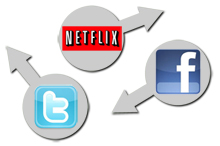Collaborating by Connecting Websites
One of the most powerful collaboration tools available is not a piece of software for employees to use on their PCs. Nor is it an enterprise social network used to break down office silos. It is a technology that’s simple, open, and often free: the application programming interface (API).

The API is a set of rules and specifications for sharing data between Internet sites. It lets Web developers access elements of an application or online “platform,” such as Google Maps or Facebook profiles, and integrate the functions into their own sites or applications. Those providing APIs can scale their products or services in an automated fashion, and those implementing APIs can add features to their sites without having to build them from scratch.
A well-known example is Facebook Connect, which is Facebook’s open API. Citysearch, among many other sites, has tapped this API to let its users log in with their Facebook accounts and share their profile information with a network of friends. Users are typically unaware of the technical aspects of the API; all they know is that the technology makes a company’s services readily available to them on more platforms.
Fred Wilson of Union Square Ventures has said an open API sped the rise of Twitter (in which his firm is an investor): “By launching with an almost totally open platform and a dead simple API, Twitter got thousands of developers to build products that had ‘Twitter inside.’ Those developers and their products pulled Twitter into the market.” Meanwhile, Twitter offers support to developers who use its API. This type of structured collaboration can help companies crowdsource several corporate functions, including marketing, business development, and innovation. Here’s how:
Marketing. A successful API can support brand building, spreading awareness and enabling companies to reach users wherever they are. Netflix’s API, for example, has been implemented at so many companies that users can access its services on more than 200 devices. Promoting the API, a strategy aligned with the company’s shift away from DVDs and toward streaming video, helped it retain market leadership even as major competitors, like Amazon Instant, entered the fray.
Business development. Big companies use self-serve APIs as a streamlined way to respond to market demand. That’s what Google is doing with its family of map APIs that developers can use for everything from everyday applications (such as Weatherbug) to obscure interests (charting roadkill across the United States). Newer companies can also use an API to gain traction. For example, photo-sharing apps Twitpic and Instagram have spread across the Web because they have simple, accessible APIs.
Often early-stage startups wait to make their APIs completely open; they require “manual” access agreed upon by both sides. That is the case for the recommendation startup Hunch.com, which requires developers to go through a vetting process before implementing its API. But the company has landed some high-profile partnerships; Gifts.com launched a gift finder using the Hunch API in December. Such collaborations can expand Hunch’s reach by 250 million monthly unique visitors, the company says. In fact, Shaival Shah, its vice president of business development, says a well-conceived API can—and should—expand the business so effectively that it will “cannibalize” some of his own job.
Product innovation. The API can act as a catalyst for making products more useful. Ford drivers, for example, can use the cars’ Sync system to access popular services like the streaming music app Pandora from the road, thanks to work done not by Ford but by external programmers through the system’s API. An API can also produce innovations in an ad hoc manner, as demonstrated by Foursquare’s Hack Day. In a 15-hour “Hackathon,” developers used Foursquare’s API to build apps including the Dealio, which gives users the ability to leave private messages for their friends at a particular venue.
APIs do carry risks. A successful API can help a company grow so fast its technology can’t keep up: Twitter, which has said its API drives 75 percent of its traffic, has struggled with service outages. On the other side, sites that plug into someone else’s API risk losing access to some data about customers—information that is often the core of a company’s business model. But the benefits remain compelling enough to suggest that this type of business-to-business collaboration will accelerate rapidly.
Carine Carmy is a senior consultant at the strategic advisory firm MarketspaceNext, where she analyzes the implications of emerging media and technology on businesses.
Keep Reading
Most Popular
Large language models can do jaw-dropping things. But nobody knows exactly why.
And that's a problem. Figuring it out is one of the biggest scientific puzzles of our time and a crucial step towards controlling more powerful future models.
The problem with plug-in hybrids? Their drivers.
Plug-in hybrids are often sold as a transition to EVs, but new data from Europe shows we’re still underestimating the emissions they produce.
Google DeepMind’s new generative model makes Super Mario–like games from scratch
Genie learns how to control games by watching hours and hours of video. It could help train next-gen robots too.
How scientists traced a mysterious covid case back to six toilets
When wastewater surveillance turns into a hunt for a single infected individual, the ethics get tricky.
Stay connected
Get the latest updates from
MIT Technology Review
Discover special offers, top stories, upcoming events, and more.